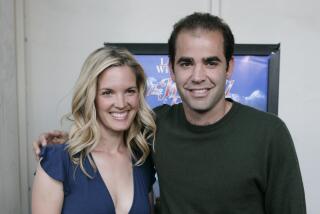Sampras Makes Mirror Image Crack
- Share via
WIMBLEDON, England — Pete Sampras had been playing tennis professionally for only two years in 1990. He was 19 and had won his first title at Philadelphia.
John Parsons, tennis writer for the Daily Telegraph of London, had just returned to his hotel room in Philadelphia when the telephone rang. It was Fred Perry, the former English player and three-time Wimbledon champion.
“John, I want this on the record,” he told Parsons. “This young man, this Pete Sampras, he can win Wimbledon. Write that I said that.”
Parsons did and Sampras has never forgotten it. Sampras, 24, has so far equaled Perry’s three Wimbledon titles, despite a shaky introduction to the tournament. He’s on his way to his fourth title, having eliminated another dangerous player in his side of the draw. Sampras advanced to the third round Thursday with a win over Mark Philippoussis of Australia, 7-6 (7-4), 6-4, 6-4.
Sampras laughed at Perry’s insight after the tense match, which in its way confirmed the accuracy of Perry’s prediction. Sampras may be the preeminent grass-court player of his generation, but his prowess required a long apprenticeship.
“I heard Fred’s comments, and it was like, ‘Wow.’ You know, I’ve never won a match here in three years, a man has to know his own limitations,” Sampras said, laughing. “I’m a little bit surprised. My dream here at Wimbledon was to win here one time; I never dreamed of winning three years in a row.”
Sampras’ opponent Thursday might have reminded him of the young player he was when Perry picked him out. Philippoussis, 19, has a huge serve and the kind of confidence and nerve that Sampras is known for. Like Sampras when he was a teenager, Philippoussis has not yet learned to play on grass.
His serve was amazing--Philippoussis had 28 aces to Sampras’ 15 with an average speed of 122 mph. What makes Philippoussis different is his second serve, which he treats much like a first. He had four second-serve aces against Sampras, one at 126 mph. He had only five double faults.
Unlike Sampras, who has greatly improved his return of serve and developed his volley and other elements of grass-court play, Philippoussis has no other tactic. His game is unformed. His style still carries the imprint of his former coach, Nick Bollettieri. Philippoussis hits hard, and if the ball comes back, he hits it harder.
With the serving what it was, there were no rallies longer than five strokes. Sampras lost only three points on his serve in the third set and by then had perfected a block-return that got the ball in play so that Philippoussis could slam it into the net.
“I haven’t quite learned how to play proper grass tennis; I have to mature more,” Philippoussis said. Each time Sampras and Philippoussis have played, it has been at a Grand Slam event. Sampras won the first meeting, in the third round of the U.S. Open in 1995. The match indicated how talented the young Australian was--Sampras struggled to win in four sets.
The next time they met, at this year’s Australian Open, Philippoussis took Sampras’ game apart in straight sets.
“The way he played in Australia was phenomenal,” Sampras said. “Basically, he kind of destroyed me.”
Sampras acknowledged he doesn’t soon forget losses and looks forward eagerly to playing the opponent again.
“I think Pete was definitely more determined for revenge,” Philippoussis said. “To let everyone know that the last time I beat him it was a bit of fluke, I don’t know.”
The women lost their second seeded player Thursday when eighth-seeded Lindsay Davenport of Newport Beach lost to Larisa Neiland of Latvia, 6-3, 6-2.
Neiland played an aggressive, pressing match that Davenport was unable to counter. Neiland played a classic grass-court game--serving and volleying--and passing Davenport when she came to the net.
“I missed a lot of my first serves, which probably killed me more than anything,” Davenport said.
“She had my second serve to do what she wanted and she’d chip and charge and drop shot a lot. I wasn’t really ever sure what she was going to do. I was unsure of when to move, and I felt awkward.”
More to Read
Go beyond the scoreboard
Get the latest on L.A.'s teams in the daily Sports Report newsletter.
You may occasionally receive promotional content from the Los Angeles Times.











